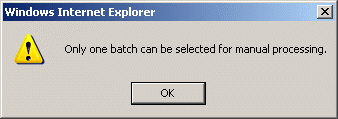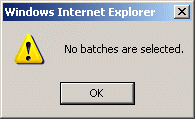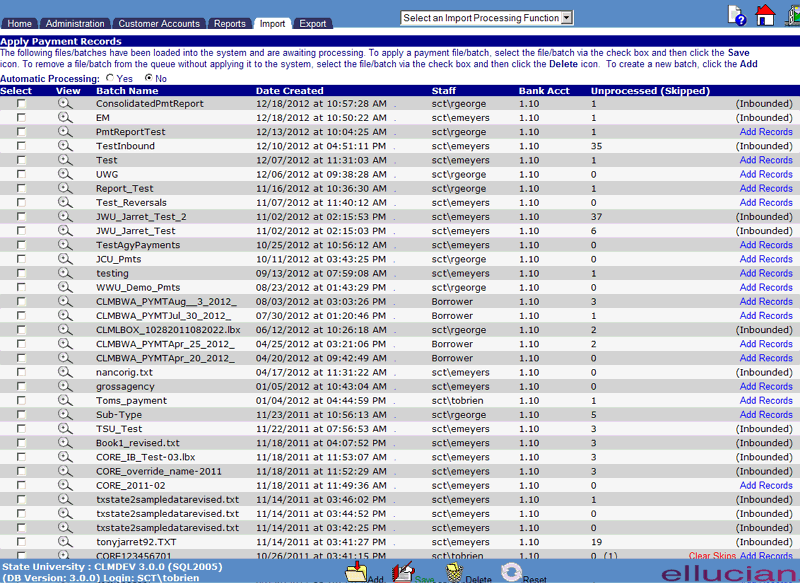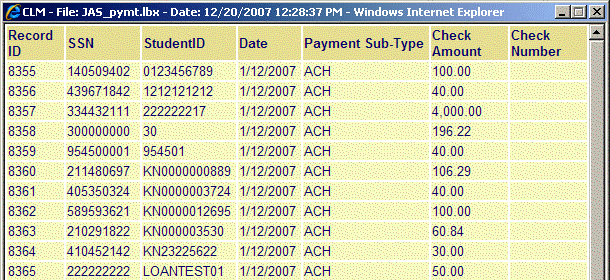![]()
![]()
Apply Payment Records
List
This function lists the Payment Record files that have been loaded from the Import Payment Records function. The Apply Payments function allows a user to:
· View Payment Records Batch File
· Add New Records to an existing Payment Records Batch File
· Add a New Payment Records Batch
· Load Payment Records Batch File Manually
o Note: if files are loaded manually, a user is allowed to edit individual records before they are applied.
· Load Payment Records Files Automatically
To view the Payment Records, click on the magnifying glass icon and new window opens that displays the records from the batch loaded from the Import Payment Records function. This allows a user to view the Records and determine whether some of them need to be changed. If the user wants to change any of the individual records, the user performs the Load Payment Records Batch File Manually process.
To Add new Payment records to an existing Batch File, click on the Add Records link and a new window opens. See Create Batch Record for details.
As an alternative to Importing an external Payment records file from the Import Payment Records function, the user can manually create a "batch" of Account records. To add a new Payment records batch, click on the Add icon in the function bar and a new window opens. See Create Payment Batch for details.
To process a file Manually, first select the No option on the Automatic Processing selection line at the top of the screen. Next select the desired file by clicking in the checkbox located to the left of the file name. When a file has been selected, click the Save icon located in the Function Bar.
Only one file can be selected for manual processing at a time. If multiple files are selected, or no files are selected, the user will be notified via a pop-up error box. The following is an example of a multiple file selection error:

After selecting a file and clicking the Save icon clicked, a new window opens to Review/Edit/Apply. The window displays up to four records (each record corresponding to the records from the original Import file) pertaining to a specific payment are retrieved from the file. See Process Batch Payments - Manually for details.
To process a file automatically, first select the Yes option on the Automatic Processing selection line at the top of the screen. Next select the desired file(s) by clicking in the checkbox located to the left of the file name. When the desired file has been selected, click the Save icon located in the Function Bar.
More than one file can be selected for automatic processing. If no files are selected, the user will be notified via a pop-up error box. The following is an example of this error:

After successfully clicking on the Save icon, the CRC system will edit the contents of the selected file(s), and apply valid records to the database. When all files and records have been processed, a Summary Results screen is displayed as shown in the following example:

This screen will list any edit errors that were found when processing the payment records. The records that were found to be in error (if any) remain in the Import file as unapplied records. You will need to use Process Batch Payments - Manually to edit these files and apply them to the system.
When you return to the Apply Payment Records screen by clicking on Close Window, it is refreshed to reflect that the previously selected file or files have been processed. If all records in a file were successfully processed, the file name is is displayed with 0 records . If one or more records had errors, the file is retained along with the erroneous records. The record count for such files is updated by reducing the records that were successfully processed.
To delete one or more unapplied Import Payment data files, first select the desired file(s) by clicking in the checkbox located to the left of the file name. When all desired files have been selected, click on the Delete icon located in the Function Bar.
Clicking the Delete icon will trigger the display of a pop-up dialog box that requests the user to confirm the Delete action, and identifies the files that have been selected for deletion. For example:

Click on the OK button to acknowledge the Delete action. The selected files will be deleted, and the pop-up window will be closed. The Apply Payment Records File List will be updated to reflect the deletion.

